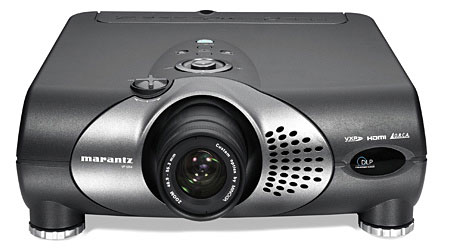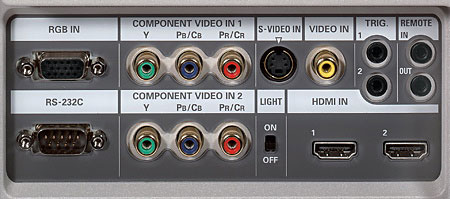Marantz VP-12S4 DLP Projector

So, that's the pickle that I'm in with the Marantz VP-12S4. It's a DarkChip3 720P single-chip DLP projector from a noble lineage that's delivered some of the finest performance yet seen from DLP front projection. It ain't 1080P, but it's here and you can buy it right now for $10,999. There, I said it, so let's move on!
The High View
The Marantz VP-12S3 was the first projector I reviewed with TI's HD2+ DMD at the heart of its light engine. While the "+" designation led me to believe it would offer an incremental improvement over its predecessor, both the chip and projector wowed me. The VP-12S4 goes further, using TI's DarkChip3 HD2+ DLP chip, which offers improved reflective properties (and thus better contrast) by flattening out the surface of each and every one of the 900K micromirrors on the DMD, and reducing the amount of dead space around each micromirror for a better "fill factor."
The VP-12S4 also knocks things up a notch by shunning the stock names in video processing and offering a solution by Gennum, a respected company in the broadcast industry. Thanks to upstarts like Silicon Optix and Gennum, Faroudja and PixelWorks aren't the only game in town anymore. Among the nifty tricks this high speed, low drag processing can perform are real 1080i processing- according to Marantz there's no converting 540-line fields to 720p here- and the ability to not only deinterlace 1080i HD, but to perform 3/2 pulldown with film-based 1080i material.
The VP-12S4 not only has an HDMI input, it has two! Hurrah! Many serious videophiles are using a DVD player and an HD set-top box with digital video outputs, so I'm pleased to see Marantz accommodate us. There are also two component inputs that will accept HD signals, and in another thoughtful addition, the jack panel at the rear of the projector has a light switch so you can see what you're doing back there in the dark!
There are a few holdovers from previous generations of this projector that probably stayed as a result of the "if ain't broke, don't fix it" school of engineering. Two of these are the outstanding optics by Konica-Minolta and the seven-segment color wheel including Marantz' proprietary "O.R.C.A." filter- which stands for Optically Reproducing Color Accurately. Aside from sharing the name of one of the worst movies ever made (how did they talk Richard Harris into that?!), O.R.C.A. is said by Marantz to enhance color fidelity by filtering excess yellow out of the bulb. The seven-segment wheel and additional filtering have upsides of delivering purer colors and eliminating rainbows (color separation artifacts), with the downside being reduced light output.

Another holdover is rather unique- the VP-12S4 ships with a special lens cap style color analyzer. Fit the lens cap over the, uh, lens, and then connect the other end to the VP-12S4's RS-232 port, and then an automatic color temperature calibration can be run from the user menus. I didn't find the results as accurate as what I get using my own tools, and I'd still recommend hiring a good ISF tech if you can, but this is an interesting concept.
Last, my review sample sported a finish new to the Marantz projector line, a black that actually appears to be varying shades of charcoal. Whatever it's called, it's very rich looking, and it makes more of an impression than the cream finish that is the other option.
Setup, Features and Functionality
The simplicity in setup of fixed pixel projectors dictates that this will be a very short paragraph. Practically point and shoot, the VP-12S4 is said by Marantz to have a wider range in its vertical lens shift. I also note (thankfully) that for my 80"wide (16:9) screen this Marantz allowed a generous range of projection- 11.5' to nearly 17'.
The VP-12S4 has a useful spate of test patterns on board, and they can be accessed from the projector's body, along with all the functions required to navigate the projectors menus, switch sources, etc. Zoom and focus are adjusted manually on the lens barrel, and the lens shift is manual as well and only accessible on the projector itself. The front feet are adjustable for leveling in a tabletop installation.
The VP-12S4's on-screen menu system is remarkable for making sense, being streamlined, and strikingly devoid of the nonsensical picture "enhancements" that plague the menus (and pictures) of many displays. And the memories for storing image adjustments are more than ample- even tweakers should be pleased with the nine User memories, each with its own custom color temperature. And each source input in the S4 defaults to the picture adjustment memory that was last used with that input. Pretty slick.
Color Temp. 3 is noted as being "about 6500K" in the user manual, and it was about that, so start there until you or your ISF calibrator can adjust it more accurately. Although there are a number of custom gamma curves, the only currently active ones are Theater, Standard and Dynamic (those lettered A-E are the same as the Standard curve as the software interface that will program them isn't available yet.) I found very little difference between the three curves with program material (especially Standard and Theater), and I'll go into that in more detail later.
There are two menu adjustments for controlling the S4's light output- Lamp Mode and Iris. The Lamp Mode defaults to Normal, and in that mode the light output is little more than adequate. I didn't want to try Economy. The Iris has two settings- the default F5.0 and F3.0. The latter setting provides only a little more light output, and as I'll describe I occasionally wanted a bit more still. More esoteric adjustments are available in two menus called Fine Menu 1 and Fine Menu 2. The first has sharpness and noise reduction as well as RGB bias and gain adjustments used to customize the color temperature. Sharpness and noise reduction default to the lowest possible settings. Oddly, while I was OK with the Sharpness at its default –25 setting with DVDs, HD looked better to me at around –10- a little crisper, but still devoid of edge enhancement. Go figure.
Fine Menu 2's defaults are chosen smartly, but just for clarity's sake I'll tell you that the Black Level settings are 0 IRE and 7.5 IRE when composite, component, or S-Video are the source, and Normal or Expand when HDMI is the source. For component and HDMI respectively, the defaults of 0 IRE and Normal will be appropriate in most circumstances. Also of note- if needed chroma delay can be adjusted in this menu.
As mentioned, the menu system is clean, intuitive, and wonderfully straightforward to navigate and use during setup and on a daily basis. The remote control is no less a marvel- a champion of economy and function. It's small, but every button counts and is well chosen. Four main buttons surround a cursor, and are backlit. There is direct access to each source input, each aspect ratio, and the preset picture memories. Additionally, there are three buttons that access the User memories in groups of three. I've never used a better remote with any product, period!
Performance
I used the VP-12S4 with Ayre's DX-7 and Arcam's FMJ DV29 via DVI and HDMI, and my DirecTV HD TiVo via HDMI. My initial sensation watching this projector was similar to when I reviewed the VP-12S3 a couple of years back- I was immediately struck by the VP-12S4's deep, inky blacks and overall dynamic range. At the time I reviewed the S3 it was a standard setter in its black level performance; with the S4, even though I've now seen many projectors that perform very well in this regard, this projector is still a standout.
Our business is called home "theater," not home video, home TV, or home sports. Theater means movies, and the VP-12S4's performance attributes are clearly skewed in this direction, just as my own viewing habits are. At least 75% of the time I fire up my system it's to watch movies, with TV shows and sports a distant second. Watching dark movies on HD and DVD like Spider-Man 2, Harry Potter and the Prisoner of Azkaban or even naturally lit but dim interiors on shows like HBO's Deadwood in HD, was simply stunning on this projector, not only for the sharp, dimensional imagery and the deep level of blacks, but also strong performance in revealing details down near black. Deadwood in particular features many finely nuanced acting performances that take place in murky, shadowy interiors, mirroring perfectly the dealings that take place in such conditions.
Occasionally, with the projector adjusted for proper black levels using industry standard test discs, some black detail was crushed with very dark material, and raising the black level made the image unacceptably lighter without revealing any more real detail near black. It's my general impression that this projector's gamma curve comes out of black a little fast in order to avoid artifacts. Dithering and false contouring are artifacts inherent, to one degree or another, in DLP technology. I'm not singling out the VP-12S4's performance in that regard, but offering my impression of the tradeoffs selected by this particular projector's designers. The VP-12S4 shows a nearly complete lack of dithering noise and false contouring in dark areas of the image, and it's possible that one reason is that the gamma curve has been tweaked specifically to minimize these artifacts. The plus side of this is that the blacks that are there are not only naturally deep, but strikingly free of noise. Nighttime skies in movies or prime time football games look deep and natural.




























































